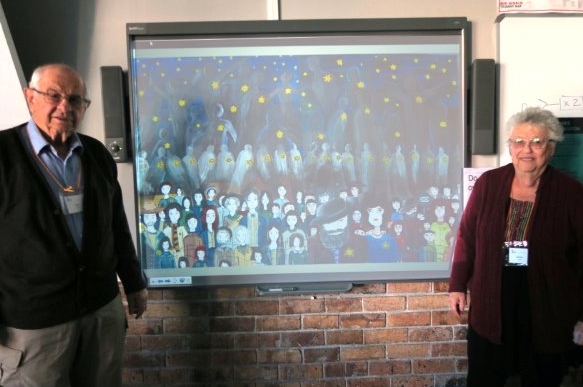
SA

Art competition helps Lithuanian kids understand the Holocaust
TALI FEINBERG
Originally from Cape Town, Abel and Glenda Levitt now live in Israel. Twenty years ago, they joined their son on a rugby tour from Israel to Lithuania, and visited the town of Plunge/Plunyan, which was where Abel’s father was born and his mother, brothers and sisters were killed in the Holocaust.
Since then, they have been back every year, building a connection with Plunyan, its people, and its past that has transformed this tiny town into a model for Holocaust education across Lithuania.
Sharing their story at Limmud Cape Town, the Levitts explained how they began this journey upon meeting the late Jakovas Bunka, known as “The Last Jew of Plunyan”, who would carve magnificent sculptures out of trees around the site of the mass graves where the Jews of the town were shot and killed.
Like so many other communities in Eastern Europe, the Jews of Plunyan were rounded up and locked in the Groyse Shul (Great Synagogue) for two weeks. On 15 July 1941, the entire community was taken to the nearby forest, where they were shot and buried in six mass graves.
Together with Bunka, the Levitts raised money to restore these memorial sites, and built a wall listing the names of every Jew killed, a process which required painstaking research over many years. They began gathering the names by looking at the lists Bunka had written in an exercise book after he returned from the war.
But the Levitts’ work has gone beyond memorialising. They aim to educate the young people of the town about what happened just 4km away in the forest, and about the Shoah as a whole. Importantly, these teens are not Jewish, and have little formal education about their country’s Holocaust history.
The Levitts were fortunate to join forces with passionate local educator Danute Sarapiniene, who envisioned building a Tolerance Education Centre in Plunyan, where young people could come after school to learn, volunteer, and create art in all its forms to understand the Holocaust. At the time, only a few of these centres existed in Lithuania.
Through incredible effort, the Levitts made the centre a reality, and it has now been replicated across the country. But they went even further, taking on an unlikely partner, Oscar award winner Sir Ronald Harwood.
“Ronnie and I were in the same class at school, and both our families came from Plunyan,” recalls Levitt, showing a class photo as proof. At the time, the Hollywood screenwriter was just Ronnie Horwitz at Herzlia High School. Levitt got in touch with Harwood, who had recently won an Oscar for The Pianist, and invited him to join them on their next trip.
The Levitts proposed to Harwood that because of his work in the arts, they create a competition in the town, in which school children would be invited to dance, sing, write, and paint their understanding of the Holocaust. Harwood agreed, and the “Ronald Harwood Art Competition” was born.
Every year, the Levitts go back to judge the entries, which pour in from surrounding towns. The competition is prestigious, the work is of the highest standard, and the awards are coveted by the youngsters who are not Jewish, but know this is a vital part of their past.
Among the rich range of artwork, some of which has been exhibited at Yad Vashem and around the globe, a disturbing painting shows a Nazi as a puppeteer, while a cartoonish line drawing manages to convey loss and fear. One of the few works outside of the Holocaust period is simply titled Before, while A Call to Humanity for Help is a stark and timeless reminder that we, too, were refugees.




